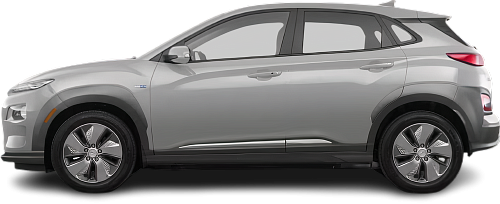USA EV Comparison: Hyundai Kona Electric Standard Range vs Volkswagen ID.4 Pure Performance
Struggling to Decide? Let AI Help!
Your AI Summary Is Ready!
General Info
Both vehicles have been discontinued and were never available for sale in the United States.
The two vehicles share the same body style: SUV.
| Property | Hyundai Kona Electric Standard Range | Volkswagen ID.4 Pure Performance |
|---|---|---|
| Years of Production | 2018-2019 | 2021-2023 |
| Current Status | Discontinued | Discontinued |
| Country of Manufacture | South Korea | Germany |
| Body Style | SUV | SUV |
| Market Availability | EU | EU |
| GCC Score | 5.2 | 5.5 |
Range and Efficiency
While the Volkswagen ID.4 Pure Performance (2021-2023) offers a longer real-world range and a bigger battery, it is less energy-efficient than the Hyundai Kona Electric Standard Range (2018-2019).
| Property | Hyundai Kona Electric Standard Range | Volkswagen ID.4 Pure Performance |
|---|---|---|
| Range (WLTP) | 180 mi | 224 mi |
| Range (GCC) | 153 mi | 190 mi |
| Battery Capacity (Nominal) | 42 kWh | 55 kWh |
| Battery Capacity (Usable) | 39.2 kWh | 52 kWh |
| Efficiency per 100 mi | 25.6 kWh/100 mi | 27.4 kWh/100 mi |
| Efficiency per kWh | 3.9 mi/kWh | 3.65 mi/kWh |
| Range and Efficiency Score | 5.8 | 5.9 |
Charging
Both vehicles utilize a standard 400-volt architecture.
The Volkswagen ID.4 Pure Performance (2021-2023) offers faster charging speeds at DC stations, reaching up to 100 kW, while the Hyundai Kona Electric Standard Range (2018-2019) maxes out at 44 kW.
Both vehicles are equipped with the same on-board charger, supporting a maximum AC charging power of 7.2 kW.
| Property | Hyundai Kona Electric Standard Range | Volkswagen ID.4 Pure Performance |
|---|---|---|
| Max Charging Power (AC) | 7.2 kW | 7.2 kW |
| Max Charging Power (DC) | 44 kW | 100 kW |
| Architecture | 400 V | 400 V |
| Charge Port | CCS Type 2 | CCS Type 2 |
| Charging Score | 4 | 4.3 |
Performance
The Volkswagen ID.4 Pure Performance (2021-2023) is rear-wheel drive, while the Hyundai Kona Electric Standard Range (2018-2019) offers a front-wheel drive system.
The Volkswagen ID.4 Pure Performance (2021-2023) boasts greater motor power and accelerates faster from 0 to 60 mph.
| Property | Hyundai Kona Electric Standard Range | Volkswagen ID.4 Pure Performance |
|---|---|---|
| Drive Type | FWD | RWD |
| Motor Type | PMSM | PMSM |
| Motor Power (kW) | 100 kW | 125 kW |
| Motor Power (hp) | 134 hp | 168 hp |
| Motor Torque | 291 lb-ft | 229 lb-ft |
| 0-60 mph | 9.3 s | 8.7 s |
| Top Speed | 96 mph | 99 mph |
| Performance Score | 3.1 | 3.2 |
Dimensions
The Volkswagen ID.4 Pure Performance (2021-2023) is longer, wider, and taller.
The Volkswagen ID.4 Pure Performance (2021-2023) boasts a more extended wheelbase.
| Property | Hyundai Kona Electric Standard Range | Volkswagen ID.4 Pure Performance |
|---|---|---|
| Length | 164.6 in | 180.5 in |
| Width (with Mirrors) | 81.5 in | 83 in |
| Width (w/o Mirrors) | 70.9 in | 72.9 in |
| Height | 61.8 in | 64.6 in |
| Wheelbase | 102.4 in | 108.9 in |
Cargo and Towing
The Volkswagen ID.4 Pure Performance (2021-2023) provides more cargo capacity, featuring both a larger trunk and more space with the rear seats folded.
Neither car is equipped with a frunk (front trunk).
The Volkswagen ID.4 Pure Performance (2021-2023) has a towing capacity of up to 2200 lb, whereas the Hyundai Kona Electric Standard Range (2018-2019) is not officially rated for towing in the US.
| Property | Hyundai Kona Electric Standard Range | Volkswagen ID.4 Pure Performance |
|---|---|---|
| Number of Seats | 5 | 5 |
| Curb Weight | 3549 lb | 4169 lb |
| Cargo Volume (Trunk) | 19.2 ft3 | 30.3 ft3 |
| Cargo Volume (Max) | 45.8 ft3 | 64.2 ft3 |
| Cargo Volume (Frunk) | - Cargo Volume (Frunk) | - Cargo Volume (Frunk) |
| Towing Capacity | - Towing Capacity | 2200 lb |
| Cargo and Towing Score | 5.3 | 6.9 |




